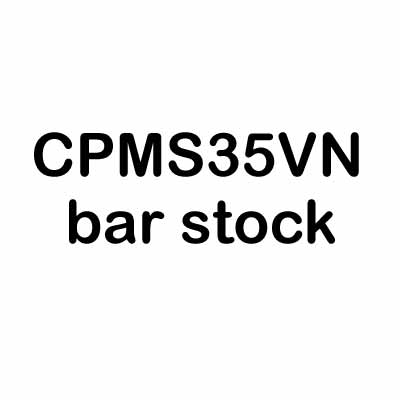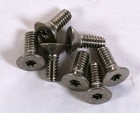CPM-S35VN **Descaled** .140" - See Length Note

CPM-S35VN Bar Stock
LENGTH NOTE:
We buy this in 36" lengths and sell it in 12", 24" and 36" lengths.
If you buy 1ea, you will get a stick 12" long by the width and thickness shown.
If you buy 2, you will get a bar that is 24" in legnth.
If you buy 3, you will get a bar that is 36" in legnth.
**If you buy 2 or 3 and want 12" length pieces, please specify in the comments section that you would like them cut into 12" pieces.
**Advertised price is for 1qty 12" piece
- Descaled
Descaled means it has been sandblasted to remove the black forging bark. There is still some forging "bark" left and pitting in the steel to remove. CPM descaled steels are always oversize in thickness to allow removal of this bark to get to the nominal thickness as specified.
This is the updated version of CPM-S30V. Crucible has added a touch of Niobium to improve toughness and reduce edge chipping. My guess is this will eventually replace CPM-S30V when the military and commercial contracts expire.
This steel was developed specifically for the custom cutlery industry. It's tough stuff - literally. Expect this steel to hold an edge longer than CPM154, 154cm or AT-34. It has a higher toughness and edge retention. This isn't a free lunch though. It will not take deep, mirror shine like CPM154 will with out a lot of effort. Plan on a nice satin finish for a user. If you want a looker that can hang in there, use CPM-154. If you want a tough user that needs to hold onto an edge, consider CPM-S30V.
Heat treat exactly the same as 154CM: Heat treat information link
Tip: My heat treat is basically this:
Wrap in 2100F Temp stainless foil. I do not put any paper in the foil pouch. I want the pouch to suck up close around the blade. Putting paper in the pouch puff's it up.
Fast ramp up 1450F, soak 10 minutes, continue fast ramp to 1950F, soak for 30 minutes.
Remove and plate quench between two 1" thick plates of aluminum. I do not remove the blade from the pouch. While quenching, I shoot compressed air between the plates. This cools everything off a little quicker.
The RC hardness I at this point averages around 61.5RC. I then put right into cryro (liquid nitrogen) for 8 hours. The hardness now averages 63RC.
I then temper twice at 450F for 2 hours each. The hardness now is 59RC.
Tip: If you are going to cryo treat your blade with Dry Ice use non-toxic RV anti-freeze instead of Acetone for the bath. It is still flammable but not as explosive as Acetone is.
From Crucible:
The proprietary Crucible Particle Metallurgy (CPM®) process has been used for the commercial production of high speed steels and other high alloy tool steels since 1970. The process lends itself not only to the production of superior quality tool steels, but to the production of higher alloyed grades which cannot be produced by conventional steelmaking. For most applications the CPM process offers many benefits over conventionally ingot-cast tool steels.
Conventional Steelmaking vs.Particle Metallurgy Processing
Conventional steelmaking begins by melting the steel in a large electric arc furnace. It is usually followed by a secondary refining process such as Argon Oxygen Decarburization (AOD). After refining, the molten metal is poured from the furnace into a ladle, and then teemed into ingot molds.
Although the steel is very homogeneous in the molten state, as it slowly solidifies in the molds, the alloying elements segregate resulting in a non-uniform as-cast microstructure. In high speed steels and high carbon tool steels, carbides precipitate from the melt and grow to form a coarse intergranular network. Subsequent mill processing is required to break up and refine the microstructure, but the segregation effects are never fully eliminated. The higher the alloy content and the higher the carbon content, the more detrimental are the effects of the segregation on the resultant mechanical properties of the finished steel product.
The CPM process also begins with a homogeneous molten bath similar to conventional melting. Instead of being teemed into ingot molds, the molten metal is poured through a small nozzle where high pressure gas bursts the liquid stream into a spray of tiny spherical droplets. These rapidly solidify and collect as powder particles in the bottom of the atomization tower. The powder is relatively spherical in shape and uniform in composition as each particle is essentially a micro-ingot which has solidified so rapidly that segregation has been suppressed. The carbides which precipitate during solidification are extremely fine due to the rapid cooling and the small size of the powder particles. The fine carbide size of CPM steel endures throughout mill processing and remains fine in the finished bar.
The powder is screened and loaded into steel containers which are then evacuated and sealed. The sealed containers are hot isostatically pressed (HIP) at temperatures approximately the same as those used for forging. The extremely high pressure used in HIP consolidates the powder by bonding the individual particles into a fully dense compact. The resultant microstructure is homogeneous and fine grained and, in the high carbon grades, exhibits a uniform distribution of tiny carbides. Although CPM steels can be used in the as-HIP condition, the compacts normally undergo the same standard mill processing used for conventionally melted ingots, resulting in improved toughness.
CPM Eliminates Segregation
Conventionally produced high alloy steels are prone to alloy segregation during solidification. Regardless of the amount of subsequent mill processing, non-uniform clusters of carbides persist as remnants of the as-cast microstructure. This alloy segregation can detrimentally affect tool fabrication and performance.
CPM steels are HIP consolidated from tiny powder particles, each having uniform composition and a uniform distribution of fine carbides. Because there is no alloy segregation in the powder particles themselves, there is no alloy segregation in the resultant compact. The uniform distribution of fine carbides also prevents grain growth, so that the resultant microstructure is fine grained. Advantages of CPM
For the End User:
|

